Offers-to-Dedicate/
Easement
Prescriptive Rights Program
Coastal Access Guide
Carbon Beach
(Malibu) Public Shoreline Access Guide
Broad Beach (Malibu) Public Shoreline Access Guide
Capistrano Beach (Dana Point) Shoreline Access Guide
Orange County Beach Access Map
Mendocino County Coastal Trails Map
Coastal Trail
Beach Wheelchairs
Right Column
Coastal Access Program: the California Coastal Trail

What is the California Coastal Trail?
The vision for the California Coastal Trail (CCT) is a continuous interconnected public trail system along the California coastline. It is designed to foster appreciation and stewardship of the scenic and natural resources of the coast and serves to implement aspects of Coastal Act policies promoting non-motorized transportation. The Trail system is to be located on a variety of terrains, including the beach, bluff edge, hillsides providing scenic vantage points, and within the highway right-of-way. It may take many forms, including informal footpaths, paved sidewalks, and separated bicycle paths. When no other alternative exists, it sometimes connects along the shoulder of the road. While primarily for pedestrians, the Trail also accommodates a variety of additional user groups, such as bicyclists, wheelchair users, equestrians, and others as opportunities allow. The CCT consists of one or more parallel alignments. It is intended that the CCT system shall be designed and implemented to achieve the following goals and objectives:
-
Provide a continuous walking and hiking trail as close to the ocean as possible;
-
Provide maximum access for a variety of non-motorized uses by utilizing parallel trail segments where feasible;
-
Maximize connections to existing and proposed local trail systems;
-
Ensure that the trail has connections to trailheads, parking areas, transit stops, inland trail segments, etc. at reasonable intervals;
-
Maximize ocean views and scenic coastal vistas; and,
-
Provide an educational experience where feasible through interpretive programs, kiosks, and other facilities.
The trail is recognized as both a statewide and national resource. Governor Gray Davis and the White House Millennium Council officially recognized the trail and it now designated as California’s Millennium Legacy Trail. The California Legislature has recognized it as a part of the statewide trail system; see report to the Legislature, Completing the California Coastal Trail [in PDF, 12 MB] and also California Coastal Trail maps [in PDF, 7.25 MB].
Does the California Coastal Trail exist today?
Yes and no, it is a work in progress. Of the 1250 miles of
coastline, about 50% of the CCT is available and is being used by
thousands of people every day.
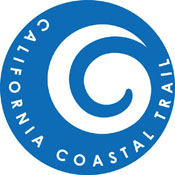 Where can I find a segment of the California Coastal Trail today?
Where can I find a segment of the California Coastal Trail today?
Just as construction of the completeTrail is a work in progress, so is
the goal of signing the Trail. At this point, several hundred
signs have been installed to mark many of the completed
segments. To find these trails, take a walk in your favorite coastal park and look for this
insignia:
You can also check out the California Coastal Commission’s guidebook series, Experience the California Coast, which contains maps depicting the currently available coastal trail segments:
- A Guide to Beaches and Parks in Northern California
- Beaches and Parks From San Francisco to Monterey
- Beaches and Parks From Monterey to Ventura ( sample pages )
- Beaches and Parks in Southern California ( sample pages )
You can view short videos which highlight various segments of the CCT here. These videos were produced with support from the California Coastal Commission, the State Coastal Conservancy, and KCET-TV.
What are the Siting and Design Standards for the CCT?
-
The trail should be sited and designed to be located along or as close to the shoreline as is physically and aesthetically feasible. Where it is not feasible to locate the trail along the shoreline due to natural landforms or legally authorized development that prevents passage at all times, inland bypass trail segments located as close to the shoreline as possible should be utilized. Shoreline trail segments that may not be passable at all times should be augmented by inland alternative routes. Special attention should be given to identifying any segments that may need to be incorporated into water-crossing structures and that necessarily must be placed within Caltrans right-of way.
-
Where gaps are identified, interim segments should be employed to ensure continuity of the coastal trail. Interim segments should be noted as such, with provisions that as opportunities arise, the trail shall be realigned as close as possible to its optimum location. Interim trail segments should meet as many of the CCT objectives and standards as possible.
-
The CCT should be designed and located to minimize impacts to environmentally sensitive habitat areas and prime agriculture lands to the maximum extent feasible. Where appropriate, trail access should be limited to pass and repass. Where necessary to prevent disturbance to sensitive species, sections of the trail may be closed on a seasonal basis. Alternative trail segments shall be provided where feasible. For situations where impact avoidance is not feasible, appropriate mitigation measures should be identified, including but not limited to use of boardwalks, reducing width of trails, protective fencing and drainage measures along edges of agricultural land, etc.
-
The CCT should be located to incorporate existing oceanfront trails and paths and support facilities of public shoreline parks and beaches to the maximum extent feasible.
-
The CCT should be designed to avoid being located on roads with motorized vehicle traffic where feasible. In locations where it is not possible to avoid siting the trail along a roadway, the trail should be located off of the pavement and within the public right-of-way, and separated from traffic by a safe distance or by physical barriers that do not obstruct, or detract from, the scenic views and visual character of their surroundings. In locations where the trail must cross a roadway, safe under- or over-crossings or other alternative at-grade crossings should be considered in connection with appropriate directional and traffic warning signage.
-
To maximize access to the CCT, adequate support facilities, such as parking areas and trailheads, should be provided.
Public and Private CCT Partnerships
The CCT is located on lands owned by both public agencies and private
landowners. As future segments will also utilize both public and private lands,
a comprehensive approach for planning, implementation and operation of the CCT
has been developed. This public/private partnership is headed by the State
Coastal Conservancy, in consultation with the California Coastal Commission and
the Department of Parks and Recreation, along with many other partners including
Federal agencies (e.g. National Park Service, U.S. Forest Service, Bureau of
Land Management, Fish and Wildlife Service, U. S. military bases), State
agencies (e.g. Caltrans, Wildlife Conservation Board), all local governments and
special districts as well as various nonprofit and voluntary private landowners.
Role of the California Coastal Commission in the CCT
The Coastal Commission is a state agency responsible for statewide coastal
planning and regulation, operating under the Coastal Act of 1976. An important
part of this responsibility is the Coastal Commission’s role as the lead agency
for CCT planning and permitting for the entire coastline. A primary objective
for the Commission is to ensure the selection of a continuous and coordinated
trail alignment, which respects and protects natural resources in a manner
consistent with the Coastal Act.
Role of the California Coastal Conservancy in the CCT
The California Coastal Conservancy is a state agency created to assist in
the implementation of the goals of the Coastal Act. In addition to the many
resource protection and enhancement programs the Conservancy supports,
maximizing recreational opportunities such as the CCT is one of the agency's
highest priorities. The Conservancy provides funding to public agencies and
private nonprofit organizations to acquire land and construct new segments of
the CCT. (You can visit
www.coastalconservancy.ca.gov for more information.)
Role of Coastwalk California in the CCT
Coastwalk California is a nonprofit public advocacy group whose main mission for over
20 years has been to heighten awareness of the CCT, through such activities as leading hikes along the coast. Coastwalk
California also has published a two volume series entitled
Hiking the California Coastal Trail which includes a series of maps depicting Coastwalk’s current recommended hiking route along the coast. Note: these maps
are not the official CCT maps. (To learn more about Coastwalk California, check
www.coastwalk.org.)
History of the CCT
Policy makers and coastal managers have long planned for a continuous
coastal trail in California:
- In 1972, Proposition 20 (the “Save the Coast” initiative) provided that “a hiking, bicycle, and equestrian trails system be established along or near the coast” and that “ideally the trails system should be continuous and located near the shoreline.” The Coastal Act of 1976 requires local jurisdictions to identify an alignment for the California Coastal Trail in their Local Coastal Programs (LCPs).
- The California Coastal Trail was designated California’s Millennium Legacy Trail in 1999 by Governor Davis and the White House Millennium Trail Council encouraged federal agencies to assist in developing it.
- State Legislation in 2001 focused efforts to complete the Coastal Trail. Assembly Concurrent Resolution 20 (Pavely) declared the Coastal Trail is an official State Trail and urged the Coastal Commission and the Coastal Conservancy to work collaboratively to complete it.
- Senate Bill 908 (Chesboro) charged the Coastal Conservancy in 2001 to prepare a plan, in cooperation with the Coastal Commission and State Parks Department, describing how the Coastal Trail can be completed. This Plan was submitted in 2003 to the legislature and is entitled Completing the California Coastal Trail [in PDF, 12 MB]. It sets forth the goals and objectives of the CCT and includes a blueprint for how missing links can be connected.
- The California Legislature adopted Assembly Concurrent Resolution No. 153 [in PDF, 44KB] proclaiming October 11, 2008 as California Coastal Trail Day
California Coastal Trail Examples
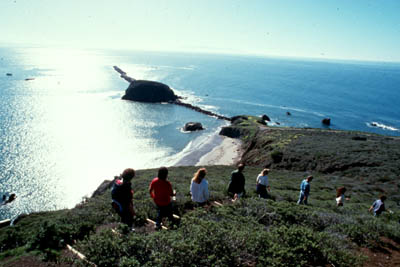
Celebrating Ten Years of Hiking the Pecho Coast Trail
Pursuant to a Coastal
Commission permit issued to PG&E,
the Pecho Coast Trail opened a 3.7 mile long stretch of coast in 1993 in an area
that was previously off-limits to the general public. Thousands of hikers have walked the Trail and have been treated to
spectacular views. The trailhead starts near Avila Beach at Port San Luis
Harbor and traverses the promontory high above Avila Bay and provides
views of the Nipomo Dunes
and the open sea. The Point San Luis Lighthouse, undergoing renovation, is
a popular stop along the way. Due to the sensitive nature of the area,
hikes are managed by trained docents, therefore call 805-541-8735
to find out when hikes are scheduled. Walks are free!
See the full brochure
for more details.
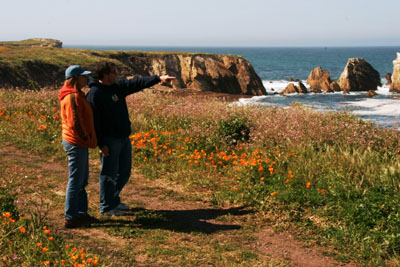
The Pt. Buchon Trail, in San Luis Obispo County, opened in 2007.
The Pt. Buchon Trail, three miles in length is managed by the
property owner, Pacific Gas and Electric. Required pursuant to a
Coastal Commission permit, this bluff top trail begins at the southern
end of Monta�a de Oro State Park, and
also includes access down to Coon Creek Beach.
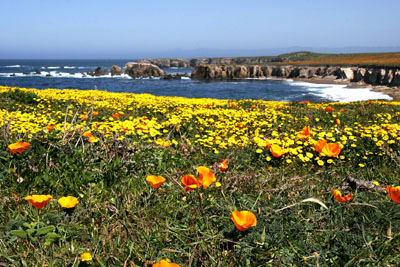
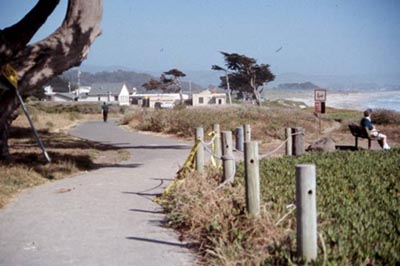
In San Mateo County,
Half Moon Bay residents and visitors enjoy the tranquility of
and view
from the 6 mile long Coastside Trail.
